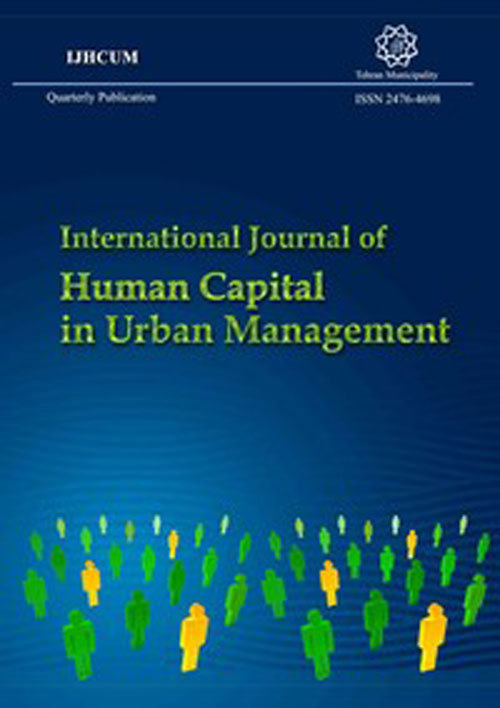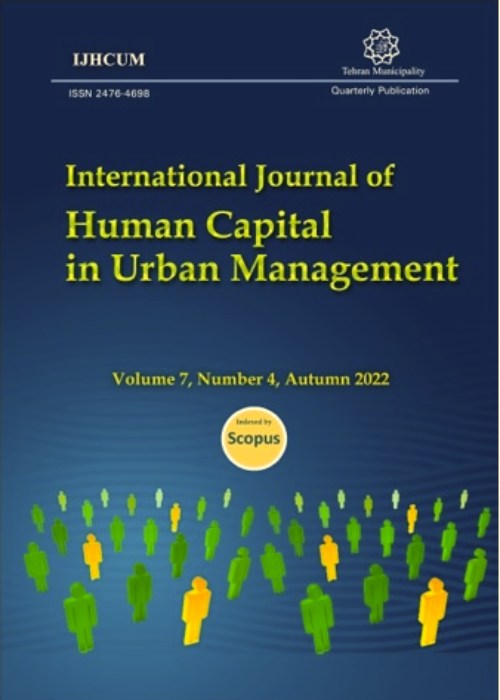فهرست مطالب

International Journal of Human Capital in Urban Management
Volume:4 Issue: 2, Spring 2019
- تاریخ انتشار: 1398/01/12
- تعداد عناوین: 8
-
Pages 77-86In this study the quality of Omani and United Arab Emirates bottled water brands which are sold in Oman were assessed by comparing the chemical composition indicated on manufacturer’s label with local and international bottled water standards. Results indicated that all the bottled water brands are complying with local and international standards. According to piper diagram, the most dominant water type among Omani brands is mixed Ca2+-Mg2+-Cl- and among United Arab Emirate brands is calcium chloride. Hierarchical cluster analysis divided Omani and United Arab Emirate brands in to four groups based on similarity in chemical composition. Some of the Omani and United Arab Emirate brands have same chemical composition, but marketed under different names. Calcium concentration in Omani and United Arab Emirate brands is low compared to imported mineral water brands, and their contribution towards recommended dietary allowances of calcium for adults is only 3%. Both Omani and United Arab Emirate brands used in this study are meeting United States Food and Drug Administration’s very low sodium category requirements and are suitable for individuals on severely restricted sodium diet.Keywords: Bottled water, Hierarchical cluster analysis (HCA), Oman, Piper diagram, Recommended Dietary Allowances, United Arab Emirate (UAE)
-
Pages 87-100A multiplex is a kind of urban cultural facilities which not only has several different rooms for showing films, but also provides other services such as a wide range of food and drink stores and free/easy available parking. Multiplexes have significant cultural, economic and social characteristics. Given the importance and advantages of multiplexes, several multiplex buildings have been built in Tehran in the last decade. However, many experts doubt that a thorough study has been done on locating them. While, precise locating is associated with more profit, better service and higher social and cultural effects. Therefore, this study reviews different spatial, economic and social criteria (as the most effective criteria on locating urban facilities) so to prioritize 22 districts of Tehran for construction of multiplex buildings. In order to achieve this goal, an index system including 10 various indices was developed. Then, a spatial decision support system was designed and implemented based on two multi criteria decision making models including stepwise weight assessment ratio analysis (SWARA) and fuzzy analytical hierarchy process (Fuzzy AHP). Computation, map production, weighting and combination of different indices and ultimately achieving final output was provided by this system. According to the application of Fuzzy AHP and SWARA models on the indices, it was determined that accessibility and income indices have the most effect on prioritization. The final results of this study indicate that Districts 2, 7 and 11 have the highest priority, and districts 18 and 17 have the least priority for construction of multiplex buildings.Keywords: Fuzzy Analytical Hierarchy Process (Fuzzy AHP), Multi Criteria Decision Making (MCDM), Multiplex buildings, 22 Districts of Tehran, Spatial Decision Support System (SDSS), Stepwise Weight Assessment Ratio Analysis (SWARA)
-
Pages 101-110Today, most countries in the world are gearing up by innovation, seeking to increase productivity and improve their economic situation, and one of the important centers for innovative activities is the incubator centered companies. The majority of companies based in incubator centers are startups companies. Considering that the failure rate of new firms in the early years of formation is greater, research should be conducted on the success factors of these companies. Therefore, the present study aims to identify the key factors for the success of knowledge-based companies Relied on academic incubator centers and it was carried out with the Meta synthesis method. Meta synthesis requires that the researcher carry out a thorough and in-depth review, combining the findings of relevant qualitative research. Using the Meta synthesis method, evaluated over 38 articles in the field of knowledge-based companies. Content mining was used to extract the dimensions and codes, and the significance and priority of each was determined by the use of the quantitative Shannon entropy method. 13 codes, 4 general concepts and 2 categories were identified by reviewing 38 articles. Shannon’s entropy was determined based on the results of the quantitative analysis. To evaluate the quality, the results are presented to one of the experts to be examined by the Kappa index Using SPSS software; a significant number of 0.000 and an index value of 0.706 were calculated. So it can be claimed that the extraction of the codes had a good reliability. The most important factor for the success of the companies located in the incubator centers of Sistan and Baluchistan University is the marketing and sales capabilities that have the highest coefficient and have the highest rankings in total. Based on the findings, it was found that the factors of marketing and sales capabilities, the presence of specialized staff and information technology related infrastructure (software, hardware, network, and brain ware), respectively, have the most impact on the success of knowledge-based companies Relied on university incubator centers.Keywords: Incubator centers, Knowledge based companies, Meta Synthesis, Shannon Entropy
-
Pages 111-118The objective of this study was to examine the evaluation of training courses applied in succession planning in organizations using the CIPP model. This was an applied research in terms of purpose and descriptive-survey in terms of data gathering type. Statistical population of the study included 100 employees of Chamber of Commerce, of which a sample size of 80 people were selected using the random sampling method and Cochran formula. Face validity and content validity were also used to assess the validity of questionnaire and Cronbach's alpha coefficient was used to calculate its reliability that the value of them was higher than 0.7, and the results indicated the validity and reliability of the researcher-made questionnaire. To analyze the data, with respect to research questions, descriptive statistics (mean, standard deviation, frequency distribution tables and charts) and inferential statistics (confirmatory factor analysis and one-sided one-sample t test) were applied using SPSS and PLS software. The results revealed that context, input, output (product) and process components in the evaluation model of training courses used in succession planning are at a favorable level.Keywords: Context Input Process Product approach Model (CIPP Model), Evaluation of training courses, Human Resource Planning (HRP), succession planning
-
The influence of event attributes on tourist’s loyalty: Evidence from the Ashoura event in Yazd CityPages 119-126Many studies have found that the perceived authenticity of cultural and religious events affects event satisfaction and loyalty. Little is currently known about how perceived authenticity is affected by the facilities, such as food and the availability of information, which are independent determinants of satisfaction and loyalty. This study aims to examine the antecedents of event loyalty. Questionnaire data were collected from 315 tourists participated in Ashoura event. This article explores this complex relationship using empirical data collected through a survey conducted during 2017 Ashoura event. The results indicate 53% of the variance of the event loyalty followed by event satisfaction and 35% of it belongs to event perceived authenticity. In addition, the results show that the greater the perceived authenticity with the event leads to the higher the degree of satisfaction with the event as indicated by a parameter estimated as 0.56 (p < 0.01). However, the relationship between facilities and event loyalty is no significant (0.006; p > 0.01). Based on the findings, the study concluded that facilities influence tourists’ loyalty through event satisfaction and perceived existential authenticity.Keywords: Ashoura event, Event Satisfaction, Facilities, loyalty, perceived authenticity
-
Pages 127-132The empowerment of small-medium scale industries must be carried out thoroughly through the provision of business development opportunities to the greatest extent so as to be able to increase the role and potential of the industries. The purpose of this study was to analyze the internal influence of the human resources competencies on technology and the organizational readiness to the level of adoption of e-commerce in craft small medium industries. The analysis used by researchers to determine the effect of each variable using multiple linear regression analysis techniques. This study shows that 79 percent of human resources owned by small medium scale industries have the expertise to operate computers and have adaptability that is fast with changes in information technology but from an organizational perspective 70 percent of them do not provide adequate information technology devices (computers/smartphones and internet networks) even though craft small-medium scale industries who are respondents 100 percent understand technological change and development.Keywords: Adoption, E-commerce, Organizational readiness, Technology competency
-
Pages 133-144Traffic is one of the main sources of air pollution in metropolitan areas. With development of transportation system, inappropriate vehicle production, and the use of low-quality fuels, increased pollution in these areas is inevitable. The current study tries to determine PM2.5, PM10, NO2, and CO emission dispersion, caused by traffic, using CALINE4 software. According to research findings, during one month in each of 3 different seasons, CO levels varied between 30-55ppm. Also, NO2 levels, at all stations in Tehran, varied between 0.1- 0.4ppm; values above 0.05 represent pollution by diesel-fueled vehicles, mostly old and outdated public transportation buses. Modeling of suspended particles smaller than 2.5 microns indicated that pollution at all of the 10 stations was between 65-113μg/m3, which was above standard (35μg/m3). In addition, during all the studied months, the amount PM10 varied between 105-193μg/m3, and in some areas, it was above the Standard of the Iranian Department of the Environment (DOE) of 150μg/m3. According to matrix of internal and external factors analysis, strategies to be considered are of Weakness/Opportunity type (benefiting from opportunities and overcoming existing weaknesses). By forming a Quantitative Strategic Planning Matrix (QSPM), W/O strategies of SWOT matrix were prioritized. As a result, increased budget for environmental control in the area (39.5), cooperation and coordination between the private and public sectors (69.4), equipping the public transportation with low-energy and green vehicles (48.4), widespread public awareness campaign (98.3), and transferring the polluting industries to suburban areas (78.3) were selected as top strategies for managing traffic-borne air pollutant in District 12 of Tehran.Keywords: Air pollution, CALLINE4, Carbon monoxide, Particulate Matters, Urban traffic, SWOT
-
Pages 145-156As a communication link between suburban and urban roads, terminals prevent buses from entering the cities, thus, they play an important role in improving traffic flow, reducing urban environmental pollution. Clearly, proximity of te rminals to cities will bring about environmental pollution in different forms (soil, water, air and wastewater). The current study tries to investigate the environmental management solutions for Tehran West Terminal. For this purpose, all the environmental aspects of bus terminals, including air, water, soil and traffic were investigated. Then, with respect to the primary assessments, a questionnaire was prepared and distributed among drivers and terminal staff. According to the obtained results, a SWOT matrix was designed and implemented after completing the Analytic Hierarchy Process. The results of soil sampling showed that pollutants like heavy metals and volatile organic matters (Benzene and Toluene) were above the standards set by the Iran Department of the Environment. In terms of air pollutants, all the gases and particles were above the standards set forth by Iran Department of the Environment. According to SWOT analysis, the aggressive scenario strategies obtained the highest scores. They included periodic trainings for the managers, drivers and other terminal staff (5.31), constant monitoring by Iran Department of the Environment (4.72), establishing internal environmental regulations (4.44), forbidding unauthorized car repairs especially oil Chang outside the repair shops (3.93), and supervision of cooperative managers on controlling vehicles and their drivers (3.73), were selected as superior strategies, respectively.Keywords: Environmental management, pollution, Bus terminal, SWOT AHP


